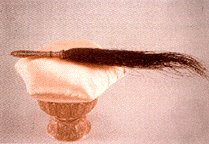:::::::::::::::::::::::::::::::::::::::::::::::::::::::::::::::::::::::::::::::::::::::::::::::::::::
Daruma carrying a flywhisk (hossu 払子)

. Kutaniyaki, Collection Gabi Greve
Flywhisk Hossu 払子
This is a whisk used to flick mosquitoes away. This tool had its practical use in India and other hot countries. Usually the whisk was made of the hair of Tibetan yak and used by highranking priests. It came to be symbolized especially in Zen Buddhism, where it stands for the swishing away of delusive thoughts and ideas which are continuously troubling the normal human being.
Since Daruma is a high-ranking priest, of course he carried such a flywhisk to flick away the moskitoes around him and the "spiritual moskitoes" in the minds of his disciples. It is not a whip, mind you.
Daruma with a Flywhisk 払子を持つだるま

This is maybe most often found as an attribute of Daruma san. Even some tiny MINI ones where depicted with it. And he does not even need hands to hold it, it can just be painted on the body. Daruma can hold the hossu in his right or left hand, have it hanging down or hold it straight upright or even recline and let it dangle over his shoulder.
Here are three examples, one little Daruma with a hossu almost as big as himself, one with just a face and a hossu as a flower vase or a tray.
Jimotsu - What is Daruma Holding? .
:::::::::::::::::::::::::::::::::::::::::::::::::::::::::::::::::::::::::::::::::::::::::::::::::::::
Since Daruma was an Indian priest, he lived in a hot country with a lot of flies in summer. It was the sign of a high priest to carry a beautiful big flywhisk to protect his own body, and as a Zen pries, I guess, he could once in a while whack a sleepy student with it too.
In India this flywhisk is called CHAURI and in Japanese HOSSU.
We have beautiful flywhisks from monks and priests in Tibet, where they are made from the hair of the tail of a yak.
The flywhisk is one of the items where you can easily recognize a Daruma figure, apart from the huge eyes and the large earrings.
Langlois Rooshi tells the following about his hossu:
Many people have asked me what the significance is of the hossu, which I am holding in my hand. It is a flywhisk, but in Zen, it has a very special meaning. It is a whisk, but it is used to swish away the many delusive thoughts that are constantly chasing us.
http://www.zbtc.org/docs/kongo/living.html
Some other figures in the Buddhist pantheon carry a flywhisk, for example the attendants and disciples of Buddha (Arhats, Jap: Rakan).
Look at this picture of Tibetan Art.

http://www.tibetart.com/image.cfm/287.html
ooo ooo ooo ooo ooo ooo ooo
The flywhisk is also one of the Royal Regalia of the King of Nepal.

King Rama IV added a Flywhisk, made from the tail of a yak, but it has been badly damaged. Therefore, the present Royal FlyWhisk, as part of the Royal Regalia, is made from the tail of an albino elephant with a gilt and enamel handle. According to ancient Indian accounts, the Wanwitchani is used by the king to ward off any maleficent which might cause discomfort to his people.
http://www.thaimain.org/eng/monarchy/fan.html
ooo ooo ooo ooo ooo ooo ooo
On this delicate picture of Indian Art you can see one of the attending ladies waving the flywhisk to keep the air around the royal couple clean.

http://www.exoticindia.com/product/HC93/aff10150/
ooo ooo ooo ooo ooo ooo ooo
Here are two great glossaries about Asian religious terms, although they do not tell much about the flywhisk, they might come in handy for other searches.
http://www.religionatlas.org/TeacherResources/Glossary/GlossaryS2.asp
http://home.att.net/~spmckee/glossary_first.html
Glossary of Indian Art Terms
http://www.fashionindia.net/glossary/glossary1.htm
:::::::::::::::::::::::::::::::::::::::::::::::::::::::::::::::::::::::::::::::::::::::::::::::::::::
Here is an example from Africa, of Jomo Kenyatta, Kenya.
The flywhisk is a symbol of a Kikuyu elder. Elegantly made from the end of a cow's tail.

by Fred Beisser, 11/15/2004
http://www.findagrave.com/
:::::::::::::::::::::::::::::::::::::::::::::::::::::::::::::::::::::::::::::::::::::::::::::::::::::
The flywhisk is quite an international tool. After all, mosquitoes are everywhere!
So, here is Daruma with the Mosquitoes !
:::::::::::::::::::::::::::::::::::::::::::::::::::::::::::::::::::::::::::::::::::::::::::::::::::::
Another item a high priest like Daruma is carring is called
NYOI 如意, a Priest's Szepter.
Details are here:
Daruma and the Priest's Szepter
Symbols and motifs seen on Chinese decorative art
:::::::::::::::::::::::::::::::::::::::::::::::::::::::::::::::::::::::::::::::::::::::::::::::::::::
[ . BACK to WORLDKIGO . TOP . ]
[ . BACK to DARUMA MUSEUM TOP . ]
:::::::::::::::::::::::::::::::::::::::::::::::::::::::::::::::::::::::::::::::::::::::::::::::::::::









1 comment:
until I hit that fly,
this was not
a fly-swatter
hae utsu made haetataki nakarishi
Kawahigashi Hekigodo
Translation by Gabi Greve
. More about the Fly Swatter (flw-swatter) and Haiku .
::::::::::::::::::::::::::::::::::::::::::::::::::::::::::::::::::::::
Post a Comment